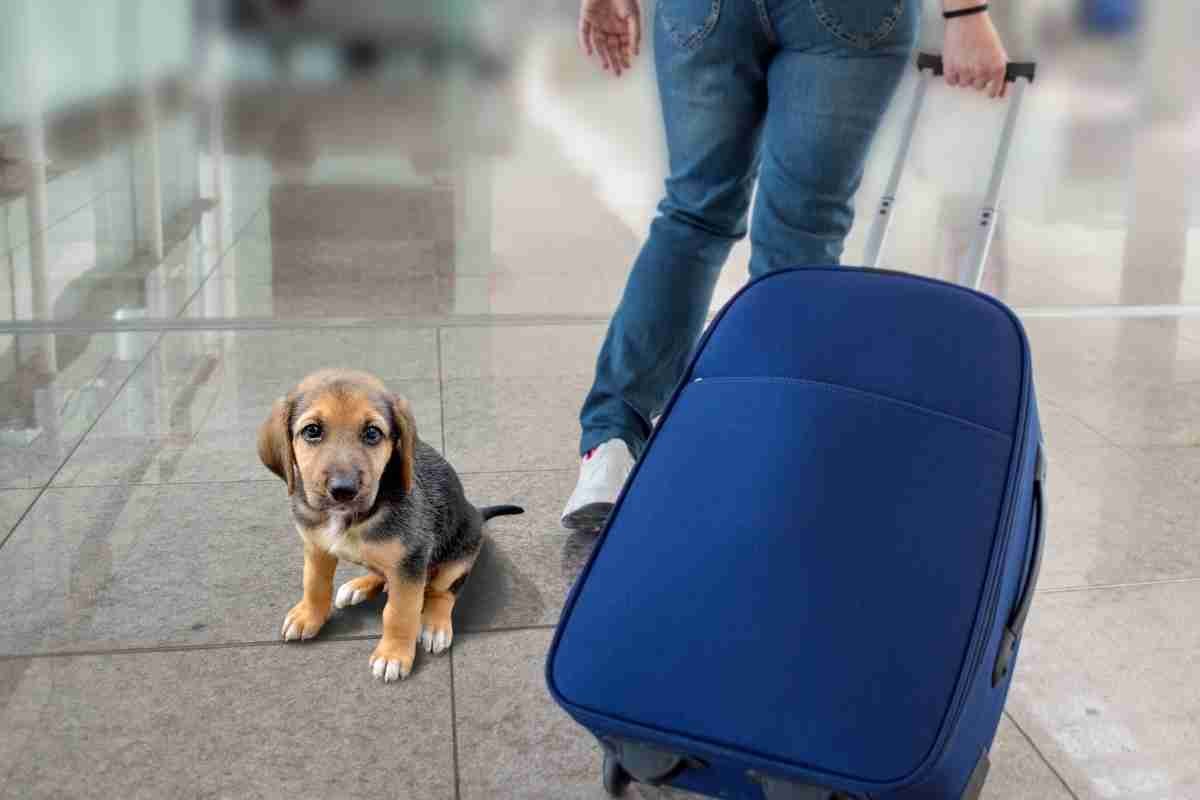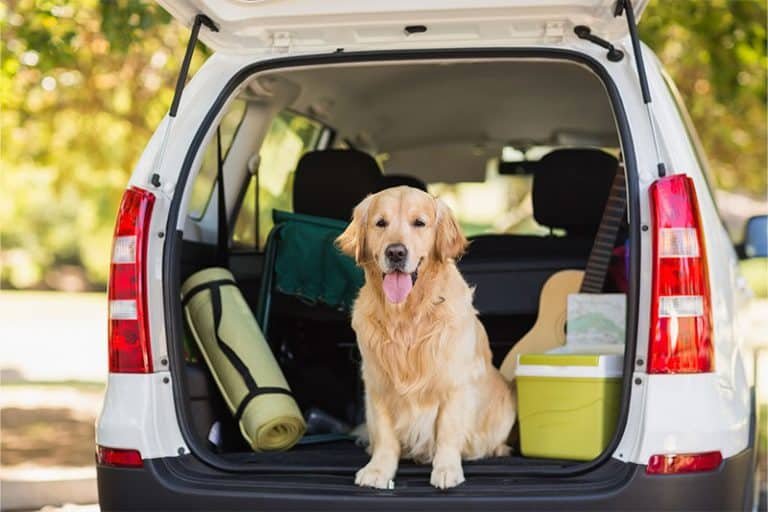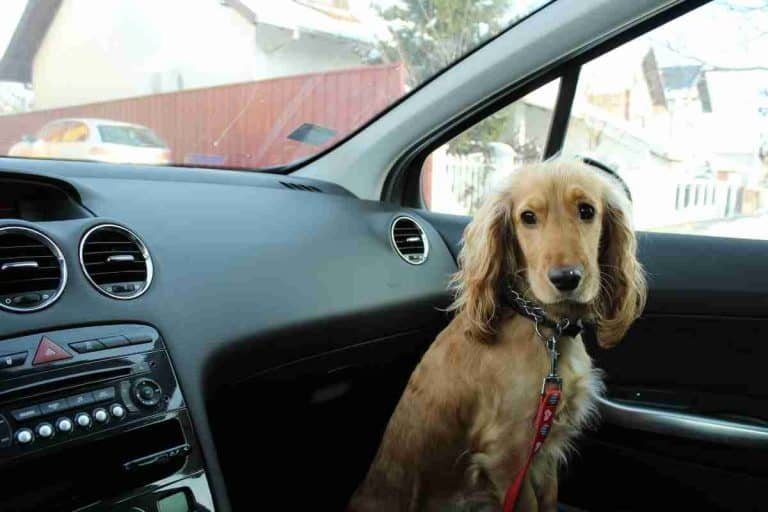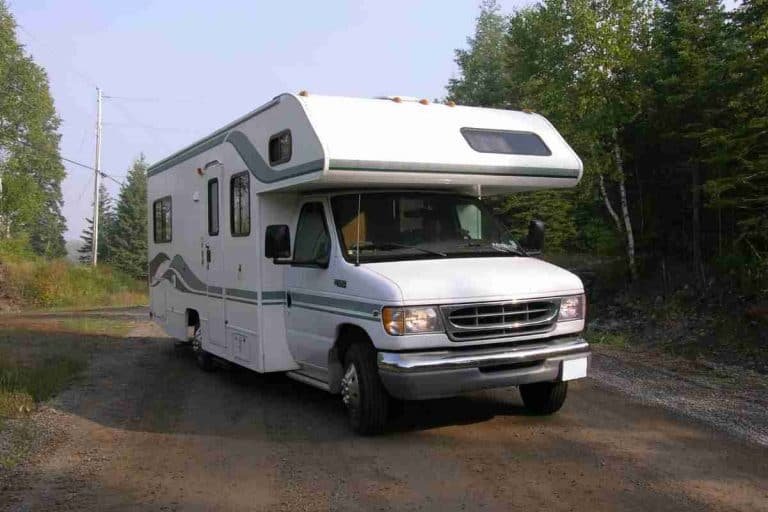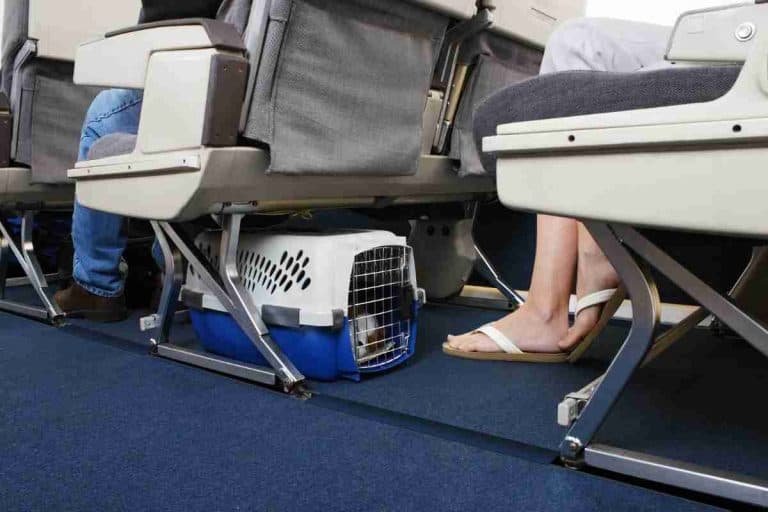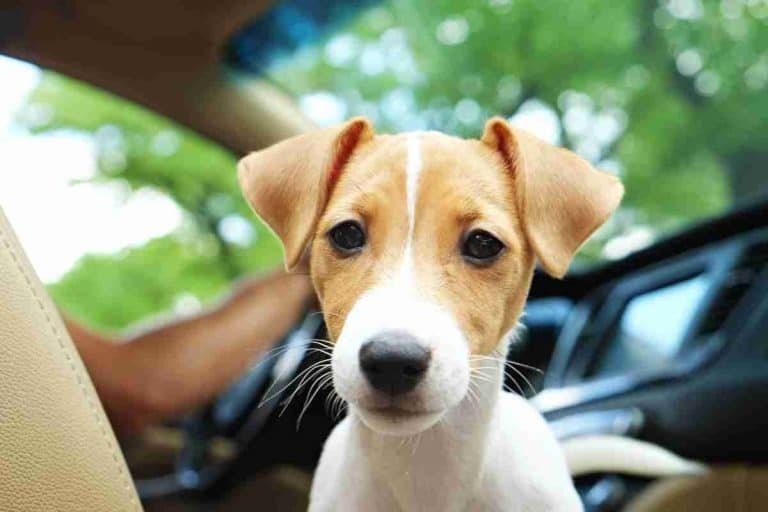8 Simple Tips to Stop Your Dog Whining on a Plane — Preflight & In‑Flight Solutions
Last Updated on August 23, 2025
Stopping a dog whining on a plane takes preparation and calm execution. With targeted preflight training and practical in‑flight solutions, most dogs settle quickly. Whining often stems from cabin noise, pressure shifts, separation, and overstimulation. These eight simple tips address each trigger with clear, actionable steps.
Readers will find vet‑informed strategies for carrier acclimation, sound desensitization, smart booking, and a calming travel kit. Day‑of routines cover exercise, feeding, airport handling, and crew coordination. In flight, reinforcement for quiet, safe distractions, and rapid de‑escalation keep cabins peaceful. A concise eight‑point checklist turns planning into a smooth, quiet trip from takeoff to landing.
Why dogs whine on planes
Whining on aircraft usually stems from a mix of physical discomfort and emotional stress. A dog can react to unfamiliar motion, sudden pressure shifts, and the constant hum of engines. Physical sensations—especially ear and sinus pressure—can cause sharp, uncomfortable sensations that prompt vocalizing. Emotional drivers include separation anxiety, fear of confined spaces, and a reaction to unpredictable stimuli.
Dogs also respond to owner tension; a nervous handler can amplify a pup’s anxiety and whining. Lack of prior exposure to travel conditions increases the chance a dog will vocalize. Short, focused conditioning and gradual exposure before a trip reduce the likelihood of distress signals becoming persistent whining.
For the specific issue of ear pain and pressure sensitivity, see Does flying hurt dogs’ ears? It explains how pressure changes affect canine ears and what to watch for before booking.
Common triggers (noise, pressure changes, separation, overstimulation)
Noise: Aircraft noise sits in frequencies dogs hear loudly. Sudden or continuous sounds can trigger alert barking and whining. A dog that startles easily will escalate vocal behavior when cabin noise ramps up.
Pressure changes: Rapid ascent or descent shifts pressure in the middle ear and sinuses. This can feel painful or disorienting and prompt whines until the dog equalizes.
Separation: Dogs with attachment issues vocalize when separated from their person or removed from familiar surroundings. Even a short loss of eye contact can trigger persistent whining.
Overstimulation: Crowds, unfamiliar scents, and tight spaces create sensory overload. When a dog cannot find a comfortable place to shut down, whining becomes a way to communicate distress.
To understand how sensitive dogs’ hearing can be and why cabin noise matters, read How far can dogs hear?
How to read stress signals before and during the flight
Recognizing stress early prevents escalation into loud, sustained whining. Common preflight signs include pacing, repeated licking of lips, yawning, and refusal to settle in the carrier. During the flight, note trembling, heavy panting, avoidance behaviors, and persistent rooting at the carrier door.
Subtle signals matter: pinned ears, whale eye, or prolonged avoidance of treats indicate rising anxiety. If a dog suddenly freezes or becomes immobile, stress may have peaked and professional help is necessary.
Practical in-the-moment steps: maintain a calm, steady tone and consistent posture; offer a high-value chew or a familiar toy; dim visual stimuli by partially covering the carrier; and avoid forcing interaction. Those steps often reduce noise without reinforcing attention-seeking whining.
If signs persist despite gentle interventions, pursue preflight strategies or consult resources like 9 natural ways to remedy your dog’s travel anxiety. If a dog shows severe distress, seek veterinary advice before the next flight.
Prepare weeks ahead: carrier and environment training
Preparation begins weeks before departure. Owners should treat the carrier as the primary travel environment, not just a container. Measure the dog, choose a well-ventilated carrier that fits airline rules, and introduce it at home as a resting spot. Start with short, pleasant sessions where the dog enters voluntarily for treats and nap time. Gradually increase duration and add low-key activities inside the carrier, such as short leash tethering, crate games, and stationary closures for a few seconds at a time. Rotate the carrier’s location so the dog learns to relax in varying household noise levels. For gear ideas and a guide to sturdy travel crates, consult the best dog crates for car travel.
Keep training consistent and frequent. Plan at least three to eight weeks of steady practice for adult dogs. Puppies need even more gradual exposure. If airline rules require under-seat carriers, practice fitting the carrier under furniture to replicate confined space. Track progress with a simple log: session length, behavior, and next-step goals. This structured preparation reduces novelty and lowers the chance the dog will whine from stress during the flight.
Stepwise carrier acclimation (short sessions → longer rides)
Begin with short voluntary visits to the carrier, three to five minutes several times daily. Reward calm entry with high-value treats, then close the door briefly while speaking softly. Increase closure time slowly, moving to five, then 15, then 30 minutes. Next, add motion: carry the closed carrier on short walks, then in a car on short drives. This helps the dog link the carrier with predictable movement and low stress.
Practice full preflight routines at home: leash up, place the carrier in a hallway, load, and walk to the front door. End each session with a calm reward and a rest period. Secure the crate during car rides to mimic in-flight immobility; tips on safe crate anchoring appear in the guide to securing a dog crate in a car. Progress only when the dog shows relaxed body language. This stepwise approach prevents overwhelming the dog and reduces whining caused by sudden change.
Simulating plane sounds and confined spaces
Desensitize the dog to cabin noise and limited space well before travel. Play recorded airplane cabin sounds at low volume while the dog rests in the carrier. Increase volume gradually across days while monitoring stress signals. Add analogous sensations, such as short car rides with windows closed and soft background announcements played through the phone.
Simulate confined space by placing the carrier in tighter locations and leaving it there with familiar bedding. Introduce mild vibrations by setting the carrier on a gently rocking platform or secure surface. Keep sessions short and pair them with rewards. For information about how flight pressure and noise affect dogs, see does flying hurt dogs’ ears. If the dog shows ear discomfort, consult a veterinarian before increasing volume or duration. Proper simulation reduces novelty and lowers the chance of whining due to surprise or discomfort during takeoff and turbulence.
Building positive associations with treats, toys, and resting cues
Make the carrier a positive, comforting place by consistently pairing it with valued items. Use long-lasting chews, puzzle toys, or a particular scented blanket inside the carrier during training sessions. Reserve those items only for carrier time so the dog anticipates pleasant outcomes when entering. Introduce a short, calm cue such as “settle” or “rest.” Pair the cue with treats and quiet praise when the dog lies down and remains still for progressively longer intervals.
Fade treats gradually, replacing them with a predictable routine: cue → toy → quiet praise → rest. Train a reliable settled behavior on the home bed first, then transfer it to the carrier. For natural anxiety remedies and calming strategies that complement these association techniques, review nine natural ways to remedy travel anxiety. Consistent pairing and a clear resting cue give the dog a reliable way to cope with airline travel and cut whining driven by boredom or anxiety.
Consult professionals and test calming options
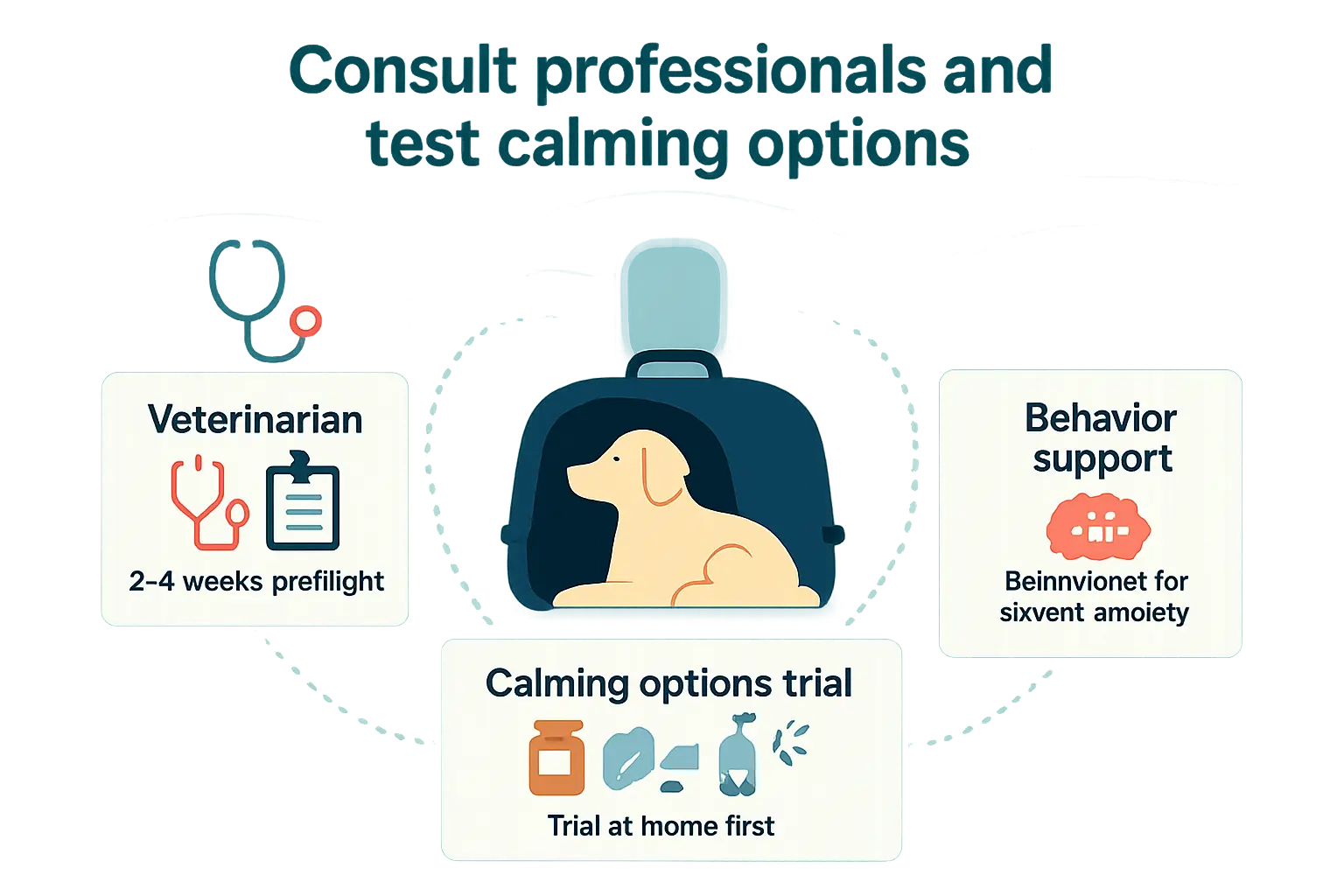
When a dog shows preflight or in‑flight distress, consult professionals early. A coordinated plan involving a veterinarian and, when needed, a behaviorist reduces surprises on travel day.
When to talk to your veterinarian (health checks, contraindications)
Schedule a vet visit at least 2–4 weeks before travel. The vet will check ears, respiratory function and overall fitness for flying. Some breeds, especially brachycephalic dogs, carry higher risk and may be advised against certain flights. Discuss vaccine records, required health certificates and any conditions that make sedatives unsafe. Ask about interactions with existing medications and whether an anxiety drug is appropriate for that specific dog.
Safely trialing supplements or prescription meds before travel
Never give new medications or supplements for the first time on a plane. Trial options at home and on short car rides first. Start with the lowest effective dose and observe appetite, coordination and elimination. Common veterinary prescriptions include trazodone or gabapentin; natural aids include pheromone sprays, L‑theanine or CBD, though evidence varies. For more natural approaches and product ideas, see 9 Natural Ways to Remedy Your Dog’s Travel Anxiety. Record effects and report results to the vet before travel day.
Working with a behaviorist or trainer for severe anxiety
For persistent or severe whining, engage a certified behaviorist or a veterinary behaviorist. They design desensitization and counterconditioning programs tailored to the dog. Typical work includes crate acclimation, sound desensitization (airplane noise), and gradual exposure to travel routines. Start behavior work months before departure when possible. Combining behavior modification with a supervised medication trial often yields the best, safest outcomes.
CTA: Have the veterinarian provide a written travel plan and a monitored medication trial before booking the flight.
Book and plan to reduce stress on travel day
The title 8 Simple Tips to Stop Your Dog Whining on a Plane — Preflight & In‑Flight Solutions highlights the importance of planning. Booking and careful preparation remove many triggers for whining. Start by choosing flights and arrangements that match the dog’s routine and temperament.
Choosing a pet-friendly flight time and seat location
Select a non-peak flight with fewer passengers and quieter cabin conditions. Early-morning or late-evening flights often offer calmer boarding and less ambient noise. Request a bulkhead or window seat when possible; these spots limit foot traffic and sudden disturbances. For small dogs, verify whether the carrier fits under the seat by checking airline dimensions. For breed-size concerns, consult resources like Dog breeds that fit under an airplane seat before booking.
Paperwork, airline carrier rules, and in-cabin restrictions
Confirm vaccination records, health certificates, and destination-specific rules at least two weeks before travel. Call the airline to reconfirm in-cabin policies and carrier size limits. Carry hard copies and digital scans of all documents in an easily accessible pocket of the carry-on. Airlines often deny boarding for missing paperwork; this causes loud, anxious reactions from dogs.
Packing a calming travel kit (blanket, toy, collapsible bowl, waste bags)
Pack a kit that recreates home comfort. Include a familiar blanket with the dog’s scent, a quiet chew toy, and a collapsible water bowl. Add waste bags and a few treats for positive reinforcement. Place an absorbent pad inside the carrier for unexpected accidents. Store the kit where a traveler can reach it quickly during boarding and turbulence.
Confirm rules and carrier fit now to reduce stress on travel day and avoid last-minute complications.
Day-of tactics to set your dog up for success
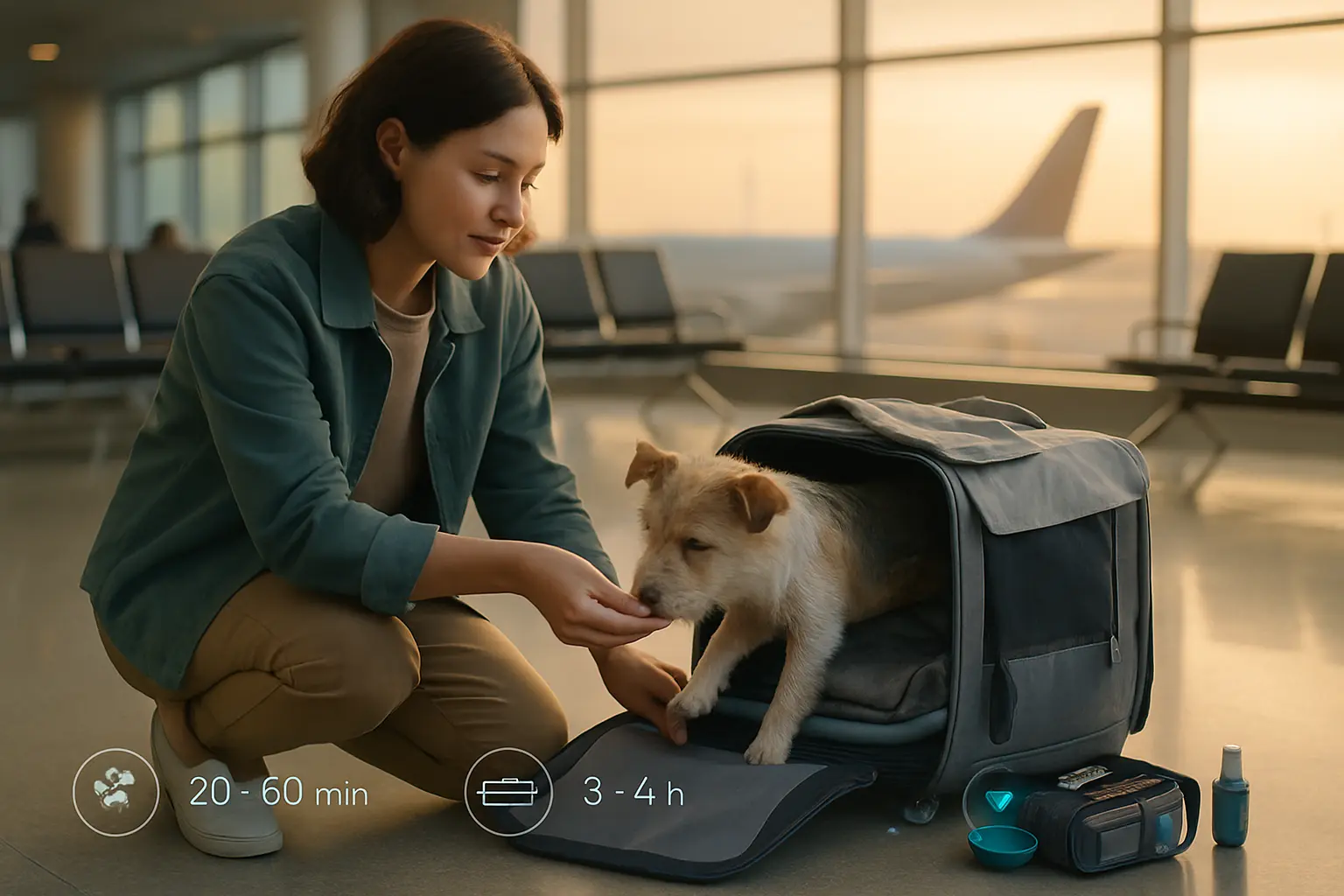
On travel day, every detail matters. Start with the carrier: line it with a familiar blanket and a worn T-shirt to carry the owner’s scent. Confirm reservation, paperwork, and crate dimensions hours before departure to avoid last-minute gate hassles. Place a secure, absorbent pad under the blanket to catch accidents without changing the dog’s scent profile. Bring a small bag with treats, vet records, a leash, and a collapsible bowl. Use a calming aid the dog already tolerates—a pheromone spray in the carrier or a snug wrap—never a new product for the first flight. Administer vet-prescribed medication only under prior consultation. Plan for short, frequent checks during layovers and keep the carrier accessible but stowed as required. If the dog shows anxiety while loading into its carrier, pause, offer a high-value treat, and close the door only once the dog settles. These day-of steps reduce triggers that provoke whining and keep the dog physically comfortable and mentally steadier during the flight. For additional preparation and gear suggestions, see essential dog travel tips and gear for road trips.
Proper exercise and last potty break timing
Exercise should tire, not exhaust. Give a brisk 20–60 minute walk depending on the dog’s age and breed. Focus on sniffing and calm engagement rather than high-impact play right before travel. A well-exercised dog rests more easily in a carrier and is less likely to whine from pent-up energy. Schedule the final potty break 20–30 minutes before airport security lines typically form. That timing lets the dog relieve itself after security delays and reduces the chance of accidents during boarding. At major airports, use designated relief areas immediately after security for a final break. Train the dog to relieve itself on a specific surface or pad so bathroom stops are quick and reliable. If a layover is long, repeat short walks and potty breaks to avoid bladder stress and whining that comes from discomfort. For practical tips about dog bathroom logistics on flights, consult how dogs go to the bathroom on a plane.
Feeding and watering rules to avoid nausea and accidents
Avoid heavy meals and free access to water just before boarding. Feed a light meal three to four hours before departure for adult dogs. For puppies or small breeds, feed two hours prior and reduce portion size. Offer small sips of water up to boarding, then stop to reduce mid-flight accidents. Place a leakproof dish in the carrier and include an absorbent pad. Do not introduce new foods, chews, or supplements on travel day; unfamiliar items can trigger gastrointestinal upset. For dogs prone to motion sickness, consult a veterinarian about anti-nausea options and the correct dosing schedule. If medication is prescribed, give it at the recommended interval so it is active during the flight. Offer a tiny, bland treat after landing to help settle the stomach, not before takeoff. These measures lower the chance of whining caused by nausea or needing to urinate unexpectedly. Read targeted motion-sickness strategies at no more doggie dramas: motion sickness tips.
Airport handling: low-stress navigation and quiet waiting strategies
Stress at the airport often sparks whining. Move calmly and avoid rushed handling. Choose quieter routes through the terminal when possible, and arrive early to reduce hurried moments. Keep the dog in its carrier during busy periods; a covered carrier reduces visual stimulation and helps the dog relax. Use soft, reassuring tones when speaking and offer short, frequent positive rewards for calm behavior. If the airline allows gate checks or in-cabin carriers, follow their guidance to avoid last-minute relocations. During long waits, set the carrier in a low-traffic corner and place a familiar-smelling item on top. If the dog tends to vocalize, a chew toy that stays inside the carrier can redirect attention. Always confirm gate and boarding policies ahead of time—some gates allow pre-boarding for pet owners, which reduces crowd exposure. Check specific carrier and cabin rules at airlines that allow dogs in cabin. CTA: verify airline pet rules and arrival windows before heading to the airport to keep the experience calm and controlled.
In-flight methods to stop or reduce whining
During flight, the crew and fellow passengers expect quiet, calm behavior. The owner must act deliberately to minimize whining while keeping the dog safe and comfortable. Start by placing the carrier under the seat as required and checking airflow and temperature inside the cabin. Monitor the dog but avoid constant interaction that reinforces the noise. Use brief, neutral reassurances only when the dog settles, and shift to a reward system that reinforces silence rather than attention for whining. If the dog shows prolonged distress, notify a flight attendant early; they can suggest a seat change or brief assistance without encouraging vocalization. Have paper towels, absorbent pads, and a small spill-proof water bottle ready for accidents. Keep identification and health paperwork within reach. Owners should avoid opening the carrier midflight unless necessary; removing a dog usually increases anxiety and may violate airline policy. For guidance on what happens when dogs vocalize on planes, consult airline-specific resources such as what happens if my dog barks on a plane. Small, consistent actions maintain calm and reduce the chance of escalating whining.
Setting up a cozy, familiar carrier space
A familiar carrier reduces novelty and limits whining. Fit the carrier with a low-profile, absorbent pad and a soft blanket that smells like home. Tuck a worn t-shirt with the owner’s scent inside; that single item lowers cortisol and helps dogs self-soothe. Use a thin, non-slip mat to prevent sliding during turbulence. Position chew-safe items so they cannot block ventilation or become choking hazards. Partially covering the carrier with a breathable cloth reduces overstimulation from aisles and strangers. Ensure mesh panels allow the dog to breathe comfortably and for the owner to check on behavior without opening the carrier. If the airline allows, secure the carrier under the seat with the seat belt looped around it. Test this setup at home first so the dog associates the exact travel arrangement with calm periods. For carrier selection and travel-ready crate options, see reviews like best dog crates for car travel. A well-prepared carrier reduces in-flight distress and whining.
Calming cues and gentle reassurance without rewarding whining
Owners should use trained calming cues rather than spontaneous comforting. Teach a short command such as settle or calm before travel. During flight, deliver the cue in a quiet, steady tone and only reinforce when the dog is silent. Avoid saying phrases or offering attention during whining; those responses act as rewards and increase the behavior. Use brief physical reassurance—one gentle stroke to the shoulder—only after a quiet interval. Offer small, high-value treats intermittently to mark silence. Use a clicker or marker word to bridge the moment between quiet behavior and reward. Body language matters: relax the shoulders, speak slowly, and avoid direct eye contact when the dog vocalizes. Consistency beats sympathy; consistent application of cues reduces whining over time. For complementary at-home techniques to reduce travel anxiety, consult resources such as 9 natural ways to remedy your dog’s travel anxiety. Properly timed reassurance reduces reinforcement of whining without ignoring the dog.
Safe distractions: chew toys, lick mats, and treat puzzles
High-engagement, safe distractions keep a dog occupied and quiet. Pack single-serving lick mats smeared with plain yogurt or canned dog food and freeze them. The frozen surface extends engagement time and reduces licking noise. Use durable, airline-safe chew toys and tether them lightly so they don’t slide into ventilation. Avoid rawhide and small pieces that pose choking risks. Offer slow-dispensing puzzle treats that release food only with prolonged manipulation. Rotate toys during longer flights so novelty lasts. Place treats and toys at the back of the carrier, where the dog can reach them without leaving the carrier or exposing paws to other passengers. Keep portions small to avoid stomach upset. Verify food rules for the airline and declare any wet foods if required. For gear and packing tips that apply to pet travel, see essential dog travel tips and gear for road trips. Thoughtful distractions occupy the dog and reduce whining naturally.
Non-pharmaceutical aids: pheromones, tested aromatherapy, and compression wraps
Non-drug aids often ease in-flight stress when used correctly. Pheromone sprays or carrier-diffusers labeled for dogs can create a calming microenvironment. Apply pheromones to bedding 15–30 minutes before flight, not directly to fur. Compression garments such as ThunderShirt provide gentle pressure that lowers arousal for many dogs. Ensure the wrap fits snugly but not tightly and that the dog can stand and lie naturally. Use low-concentration, dog-safe aromatherapy only when research supports the product and a vet approves. Avoid undiluted essential oils; many are toxic to pets. Do not use prescription sedatives or over-the-counter drugs without veterinary guidance; sedation alters temperature regulation and hearing sensitivity. Owners should consult a veterinarian before first-time use of these aids; the vet can recommend timing and products tailored to the dog. When uncertain, schedule a quick call with the vet before travel to confirm safety and dosing.
If whining starts: quick de-escalation steps
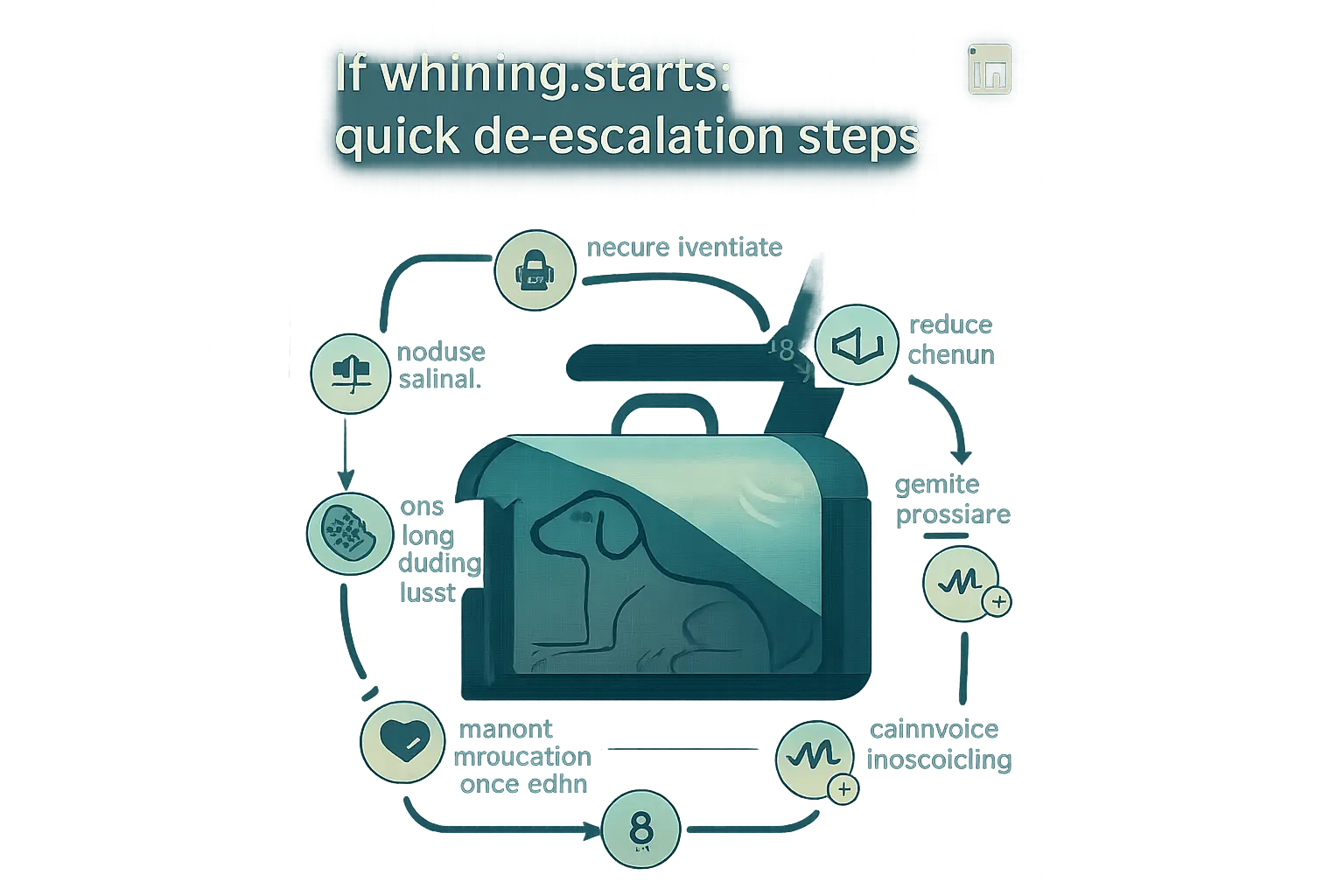
The owner should move through a short, predictable checklist to reduce the dog’s stress fast. First, confirm the carrier is secure and zipped, with enough ventilation. If the dog rides loose under the seat, clip a harness to a short tether to prevent frantic escape attempts. Lower the brightness and sound level around the dog by politely asking nearby passengers to close laptops or lower music, then shield the carrier with a lightweight blanket to dim visual triggers.
Offer a single long-lasting chew or stuffed toy that the dog already accepts. Avoid multiple treats that can upset the stomach. Apply gentle pressure—covering the carrier’s top or using a soft wrap—can calm many dogs through deep-pressure effects. Keep the voice low and steady for short reassurances; do not scold. Monitor breathing, gum color, and pacing. If the dog’s whining stops and behavior relaxes, keep interactions minimal to avoid re-exciting the animal.
For preflight gear ideas and quick calming tools owners can pack, see essential dog travel tips and gear for road trips.
Calm owner behavior and simple redirection techniques
The owner’s body language sets the dog’s tone. Slow breathing, relaxed shoulders, and minimal movement convey safety. Speak with short, soft phrases—one- or two-word cues like settle or easy. Avoid high-pitched praise or repeated scolding. If the dog responds to touch, a brief shoulder massage through carrier mesh or a gentle neck rub can interrupt whining without overstimulating.
Use a trained redirection: a pre-taught cue that switches attention to a treat, toy, or nose work. A rolled-up towel with a hidden treat, a frozen stuffed toy, or a lick mat can occupy the dog for minutes. For dogs that tolerate clicker training, a single marker-and-reward for quiet behavior reinforces calm quickly. If the owner practices these methods during short trips beforehand, they become reliable responses during flights.
More calming approaches and natural remedies owners can practice before travel appear in 9 natural ways to remedy your dog’s travel anxiety.
When to notify flight crew and what to ask for
The owner should alert a flight attendant when whining continues after initial de-escalation or if the dog shows physical distress. A concise report helps the crew assess options: explain the dog’s symptoms, what the owner has tried, and whether the dog has medical needs. Ask staff if cabin movement can be reduced near the dog or if a flight attendant can briefly monitor the dog while the owner fetches water or a chew.
Requesting assistance politely often yields practical help: a cup of water, permission to open the carrier for a quick check if the dog calms, or advice about the nearest lavatory area for emergency relief stops on longer flights. The crew can also document the incident, which helps if veterinary care becomes necessary after landing. If the dog’s behavior risks other passengers’ safety or comfort, ask about alternative seating or, rarely, flight diversion protocols.
For guidance about airline policies on noisy dogs, consult what happens if my dog barks on a plane.
Recognizing signs that the dog is unsafe or needs immediate help
Owners must distinguish persistent whining from medical emergencies. Immediate alarm signs include labored or very rapid breathing, pale or blue gums, collapse, repeated vomiting, unresponsive behavior, severe trembling, or seizure activity. Excessive drooling with foaming, blood from the mouth or nose, or inability to stand also indicate urgent problems.
If any of these signs appear, notify a flight attendant at once and request emergency assistance. State the dog’s critical symptoms and ask the crew to contact the captain or request medical personnel on board. While cabin crews cannot provide veterinary care, they can prioritize an emergency landing or arrange rapid transfer to a veterinary clinic after arrival.
Owners concerned about changes caused by altitude or pressure should review information about ear and sinus effects on pets, such as does flying hurt dogs’ ears?, before travel and be prepared to act immediately if the dog shows severe distress.
Final checklist and eight actionable takeaways
Ready-to-use 8-point checklist
1) Start carrier training early
Introduce the carrier weeks before travel. Make short, daily sessions that build positive association. Reward calm behavior and increase time inside gradually.
2) Simulate flight sounds and crowds
Play airplane cabin noise at home and practice in busy areas. Combine sounds with treats so the dog links noise to calm outcomes.
3) Consult your vet and test remedies ahead of time
Schedule a vet visit well before the flight. Test any supplements, pheromones, or prescription options on short trips first. See practical calming options at 9 natural ways to remedy your dog’s travel anxiety.
4) Pick a less crowded flight and check airline rules
Choose off-peak departures and nonstop routes when possible. Confirm carrier dimensions, fees, and seat-row rules with the airline in advance.
5) Tire your dog out and time food/water properly
Give a brisk walk or play session before airport arrival. Offer a light meal hours ahead and limit water immediately before boarding.
6) Pack familiar items and a calming kit
Include a favorite toy, blanket, calming spray, treats, and waste bags. Keep the kit easily reachable during boarding and stowage checks.
7) Use in-flight calming routines and safe distractions
Maintain a steady, low voice and short massage intervals. Offer chew-safe treats or puzzle toys to shift focus from noise.
8) Have a plan for escalation and professional help if needed
Know the airline’s policies on excessive noise. Arrange a trainer or behaviorist consult if travel causes lasting anxiety.
Action: Save or print this checklist and review it the day before travel.
Summary
8 Simple Tips to Stop Your Dog Whining on a Plane — Preflight & In‑Flight Solutions equips travelers with step-by-step strategies to prevent and calm vocalization from takeoff to landing. It explains why dogs whine—noise, pressure changes, separation, and overstimulation—then lays out practical preparation: carrier acclimation, sound desensitization, booking choices, paperwork, packing, and day-of routines that lower stress.
The guide also covers in-flight techniques that reduce noise without rewarding it, including trained calming cues, safe distractions, and non-pharmaceutical aids. Clear de-escalation steps, emergency signs, and guidance on when to involve a veterinarian or behaviorist help owners keep flights quiet, safe, and compliant with airline rules.
Key Takeaways
- Start early: Build carrier comfort and sound desensitization 3–8 weeks ahead; pair the space with chews, toys, and a trained “settle” cue.
- Consult pros first: See a vet 2–4 weeks before travel, rule out ear issues, and trial any supplements or prescriptions at home; consider a behaviorist for severe anxiety.
- Book smart and prep documents: Choose off-peak flights and quieter seats, confirm carrier dimensions and policies, and carry required health paperwork.
- Pack and time the day: Bring a calming kit (familiar blanket, chew, pheromone spray, absorbent pad), exercise appropriately, and time light meals and water to prevent nausea and accidents.
- Reinforce quiet in flight: Set up a cozy, covered carrier with good airflow; use cues to reward silence, rotate safe chews/puzzles, and avoid opening the carrier unless necessary.
- De-escalate quickly if whining starts: Dim stimuli, offer one long-lasting chew, apply gentle pressure, keep handling calm, and alert crew if distress persists or safety concerns arise.
FAQ
- What causes dogs to whine on planes? Common triggers include loud cabin noise, ear and sinus pressure shifts, separation from the owner, and sensory overload. Health discomfort—especially ear pain—can intensify vocalizing.
- How far in advance should carrier training begin? Most adult dogs benefit from 3–8 weeks of daily, gradual sessions; puppies usually need longer. Progress from open-door rest to closed-door stays, then add motion and real-world routines.
- How can whining be stopped mid-flight without reinforcing it? Use a pre-trained “settle” cue and reward only quiet moments with brief treats or a calm stroke. Partially cover the carrier, offer a safe chew, and keep interactions low-key.
- What calming aids are safe to try for flights? Dog-pheromone sprays, well-fitted compression wraps, and vet-prescribed anxiolytics can help when tested beforehand. Avoid first-time use on the plane and never sedate without veterinary guidance.
- How should feeding and watering be handled before flying? Offer a light meal 3–4 hours before departure (about 2 hours for small breeds/puppies) and small sips of water up to boarding. Limit intake just before takeoff to reduce nausea and accidents.

